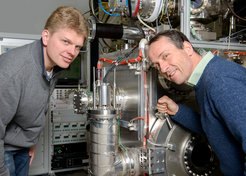Göttingen researchers reveal why hydrogen atoms bind to metals
Imagine a skilled billiard player striking a ping-pong ball against a billiard ball. Everyone knows intuitively what happens: The pong-pong ball bounces back from the billiard ball while the billiard ball does not move. This is due to the large mass difference between the two balls. It prevents the ping-pong ball from effectively transferring its kinetic energy to the heavier billiard ball.
When applying this analogy to light hydrogen atoms striking heavy metal atoms at the surface of a solid metal, however, researchers observe surprising differences: Unlike the ping-pong ball, the light hydrogen atom does not bounce back in every case but sometimes sticks to the surface. It is this adsorption of atoms which makes chemical reactions at surfaces possible in the first place. But why do atoms behave so differently from played balls?
Why atoms “stick” to metal surfaces has now been revealed in a sophisticated experiment by a team of scientists working with Oliver Bünermann, head of the group Atom-Surface Scattering Dynamics at the University of Göttingen, and Alec Wodtke, Director at the Max Planck Institute (MPI) for Biophysical Chemistry and Professor at the Institute for Physical Chemistry of the University of Göttingen. In order to understand in principle how atoms adsorb to surfaces, the Göttingen researchers investigated the theoretically simplest case: how hydrogen atoms behave at different surfaces. “Therfore, we shot hydrogen atoms with a defined speed at a gold and a xenon surface. Both elements have completely different properties: Gold is an electric conductor harboring free electrons. The inert gas xenon, on the other hand, is an insulator without free electrons,” Alec Wodtke explains. Then, the scientists measured how fast the hydrogen atoms bounced back. Based on the speed lost in the collision they calculated how much energy had been transferred from the hydrogen atoms to the surface.

“In our experiment, hydrogen and xenon atoms behaved quite similarly to ping-pong and billiard balls. The hydrogen atoms bounced back from the much heavier xenon atoms and hardly lost any energy during the collision. However, hydrogen atoms shot at heavier gold atoms behaved in a different way. They lost most of their energy,” says Oliver Bünermann, first author of the publication which now appeared in the journal Science. “The answer to the riddle is that gold – in contrast to xenon – has free electrons. They affect the hydrogen atoms like a viscous liquid and slow them down.”
This experiment was technically exceptionally demanding. “Four perfectly coordinated lasers and a complex ultra-high vacuum chamber were required,” Oliver Bünermann explains. Also, xenon is gaseous at room temperature. In order to bring xenon into a solid state, the researchers had to cool it down to 45 Kelvin (minus 228 °Celsius). “Realizing this sophisticated experiment was only possible here at the Göttingen Campus – not only because of the great scientific environment on site, but also thanks to the excellent technical colleagues in the workshops at the MPI for Biophysical Chemistry and at the University of Göttingen. All pieces of equipment were developed here in Göttingen,” Alec Wodtke says. Furthermore, three PhD students helped achieving this success. Yvonne Dorenkamp and Hongyan Jiang contributed fundamental experimental data, and Svenja Janke decisively supported the experimental evaluation with a completely new theoretical analysis of the processes.
The scientists’ findings are a crucial step on the way to understanding in detail how chemical reactions at surfaces proceed. “Our experiment provides valuable data that can be used to verify and further develop theoretical approaches. It substantially contributes to the development of a theory that might in future be used to optimize catalytic processes and to identify new catalytically effective compounds,” emphasizes Alexander Kandratsenka, head of the group First Principles Simulations of Molecule-Surface Dynamics at the MPI for Biophysical Chemistry. (cr/fk)





